Advance Electronics
Advance Electronics Ltd. of Bishops Stortford, England, made several models of desktop and hand-held calculators, starting in summer 1972. Some of the models were produced as self-assembly kits, and some were manufactured and labelled for Phytron Electronics and Fi-Cord.
The philosophy of the company was stated to be to give "reliability and value for money rather than such dubious advantages as extreme miniaturisation". There is information about the company at the bottom of this page.

In late 1972, after producing the Wireless World calculator kit, Advance Electronics announced a range of calculators[1]:
"A range of five new electronic calculators has just been announced by the British firm Advance Electronics Ltd.
Because of large scale integration whereby all the electronics can be placed in a handful of discrete
packages, assembly costs of complex instruments have been reduced drastically. The features which Advance are promoting are reliability and value for money rather than dubious advantages as extreme miniaturisation [a dig at the Sinclair Executive which had received a lot of publicity due to its small size].
The new range consists of four desk-top calculators known as the Executive 16 range and a
pocket-sized calculator known as the Executive.
The Executive 16 range all feature 16 digit capability and a keyboard specially designed for high speed work. The keyboard allows a key to be pressed even when
another has already been pressed providing that they are released in the correct order.
The basic model (retailing at £95) has the four basic arithmetic functions as well as a "%" key.
The 16 + 1 (at
£115) has a versatile memory with full 16 digit capacity which can also function as an accumulator for automatic list totalling.
The 16 + 2 (at £145) is especially suitable for V.A.T. calculations featuring two
memories.
The 16R (at £175) has all the features of the 16 + 2 but also includes a square root key.
The fifth member of the range is an eight-digit portable (at £52.50) with a plinth for desk use and
mains power supply option extras."
In late 1973 it was announced[2]:
"The Advance 160 family of desk calculators have been introduced to replace the very successful
Executive 16 range.
The four models are:
Advance 161 1 memory £115.
Advance 161R 1 memory with square root £130.
Advance 162 2 memory
£145.
Advance 162R 2 memory with square root £175."
Many of these models used calculator integrated circuits from General Instrument Microelectronics (GIM) in Glenrothes, Scotland. GIM produced custom chips to Advance's specifications and applied the Advance capital 'A' logo to them.
In December 1974 the journal 'Practical Electronics' reported that Advance Electronics had become a wholly-owned subsidiary of Gould Inc., of Chicago[3].
Known Advance models
Desk Calculators
- Wireless World kit calculator aka Executive 8, red LED display.
- Executive 16
- Executive 16+2 (aka 162) - Has two memories, red LED display.
- Executive 16R - Has two memories & square root, red LED display.
- 161 (aka 16-1) - Has one memory, Panaplex gas-discharge display.
- 161R - Has one memory & square root, Panaplex gas-discharge display.
- 162P - Programmable, Panaplex gas-discharge display. Available with "Plastic Tape Input".
- 162R - Has two memories & square root, Panaplex gas-discharge display.
- Analysis 14 - has 14 memories accessed by a grid of keys! See Phytron Analysis 14.
Hand-held Calculators
- 80
- 82R / Phytron 32
- 88
- Executive 8
- International Calculator kit - build-it-yourself kit version of the Mini Executive.
- Mini Executive
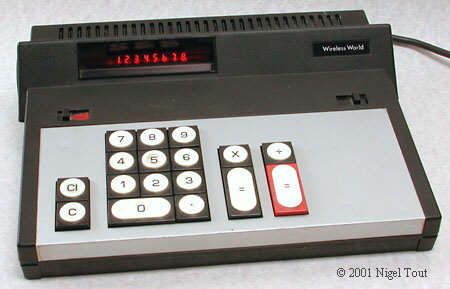
The slide switch at top left is to adjust the display brightness to one of three levels - an unusual feature.
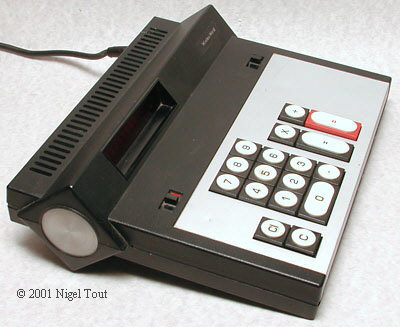
Side view showing the unusual shape.
Wireless World aka Advance Executive 8 desk calculator kit.
8 Digits, red LED
4 functions.
252 mm x 200 mm x 72 mm (10" x 8" x 3").
Integrated circuit is the Texas Instruments first "calculator-on-a-chip", the TMS1802, here date coded week 38 1971. All calculator functions are provided in the single Large-Scale Integration (LSI) integrated circuit
Assembled from a kit produced by Advance Electronics in conjunction with the electronics and radio magazine "Wireless World". Details appeared in the September & October 1972 issues.
The cost
was GBP £39.25 (about US$100).
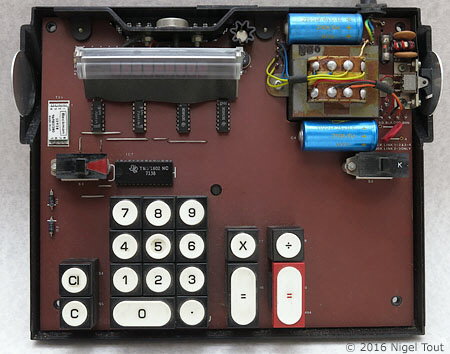
The circuit board showing, just above the keys, the calculator integrated circuit, the Texas Instruments TMS1802 "calculator-on-a-chip".
Far left is the white, hybrid thick-film integrated circuit with the clock generator circuit, which helps to reduce the number of components.
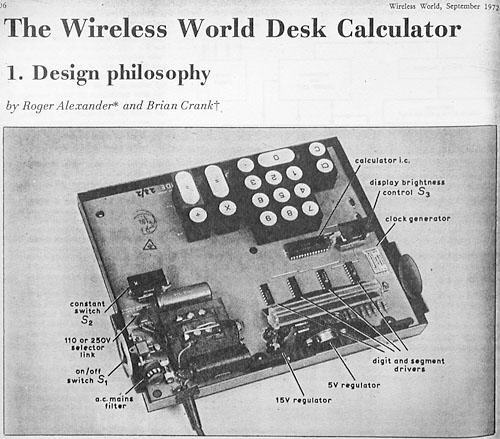
"Calculators - the kit approach[4]
Advance Electronic's Executive 8 calculator is now
available as a kit. Though not as up to date as Advance's latest machines, the Executive 8 nonetheless lends itself well to assembly by a competent amateur constructor. Marketed in this form through the October issue of Wireless World,
the kit costs £40 against its normal retail price of £79.
'Building instructions' says marketing director Rex Nelson, 'are detailed and clear but must be followed accurately. So far all those that have been
put together have worked first time.'
Nelson has been amazed at the demand for the kit, over 400 having been sold."
Calculator self-assemby kits:
Several electronics magazines featured calculator designs in the early 1970s, and several companies supplied calculator self-assembly kits, including Heathkit (see the Heathkit IC-2009) and Sinclair. These gave some cost saving and also the satisfaction of having assembled the
calculator oneself.
The kit companies usually had a scheme whereby you could return the calculator for sorting out if it did not work properly!
In Britain there was an extra price advantage for the kits since they did not attract the Purchase Tax which was applied to complete calculators. This advantage was lost from April 1973 when the all pervasive Value Added Tax (VAT) was introduced, which applied to almost all products.
Within a few years all there was inside a calculator was the integrated circuit chip, the display, and the keyboard. The assembly cost was very little so kits had no advantage and died out.
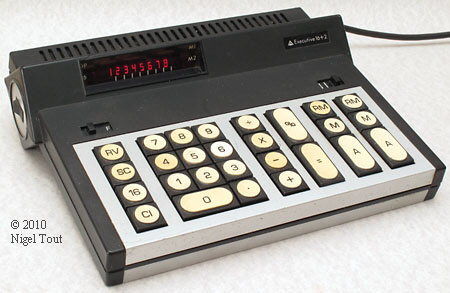
Advance Executive 16+2 aka 162 desk calculator with two memories.
8 Digits, red LED behind red filter.
Will accept and calculate with 16 digits and display either the 8 most-significant digits or 8 least-significant digits as needed.
4 function, %, two memories.
The two main integrated circuits have the Advance Electronics "A" logo printed on them, since they are custom designs for Advance. One is the GIM3 52972 from General Instrument Microelectronics, and the other (date-coded week 31 of 1973) has the part number H52973 and no other indication of manufacturer, but would be GIM.
252 mm x 200 mm x 72 mm (10" x 8" x 3").
One IC date coded early 1973.
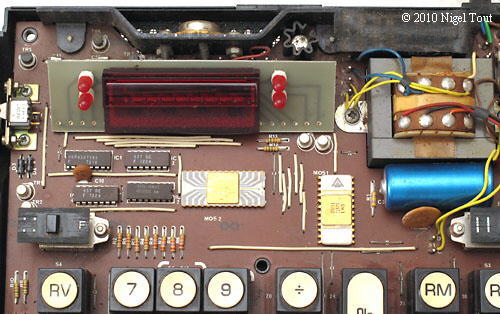
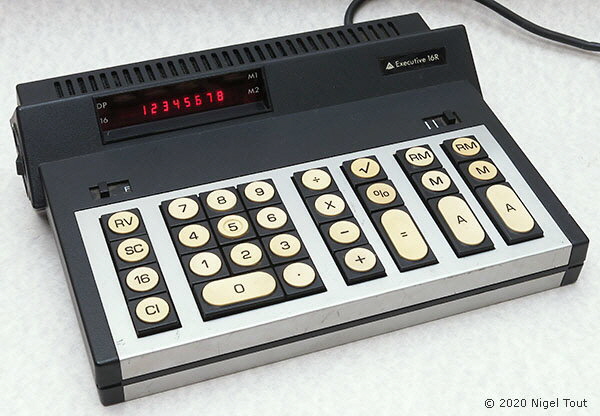
Advance Executive 16R desk calculator with two memories and square root.
8 Digits, red LED behind red filter.
Will accept and calculate with 16 digits and display either the 8 most-significant digits or 8 least-significant digits as needed.
4 function, %, square root, two memories.
The two main integrated circuits have the Advance Electronics "A" logo printed on them, since they are custom designs for Advance. One is the GIM3 52972 from General Instrument Microelectronics, and the other has a GIM3 part number (which is partly covered over) 52???.
252 mm x 200 mm x 72 mm (10" x 8" x 3").
One IC date coded early 1972.
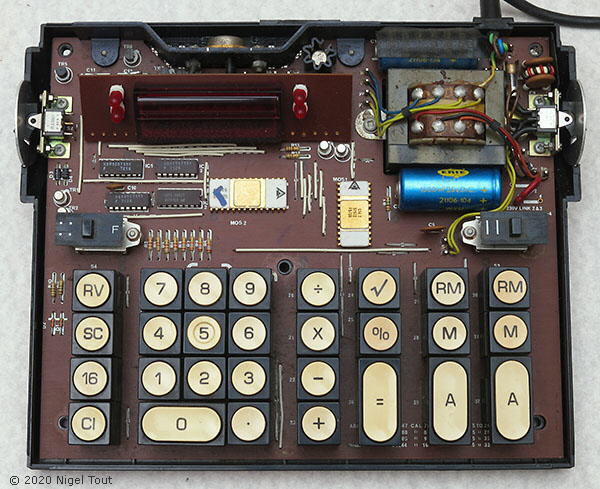
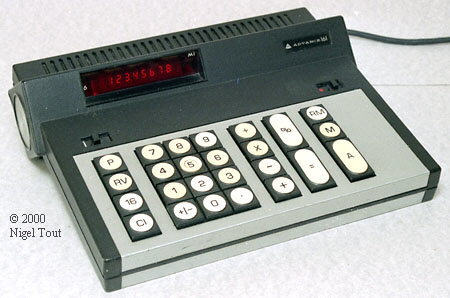
Advance 161 aka 16-1 desk calculator with one memory.
8 Digits, amber gas discharge behind red filter.
Will accept and calculate with 16 digits and display either the 8 most-significant digits or 8 least-significant digits as needed.
4 function, %, memory.
Main integrated circuits by General Instrument Microelectronics based around the GIMT4 chip. They have the Advance Electronics "A" logo printed on them, since they are custom designs for Advance.
252 mm x 200 mm x 72 mm (10" x 8" x 3").
Announced in September 1973 with a price of GBP £115[2] (about US$260).
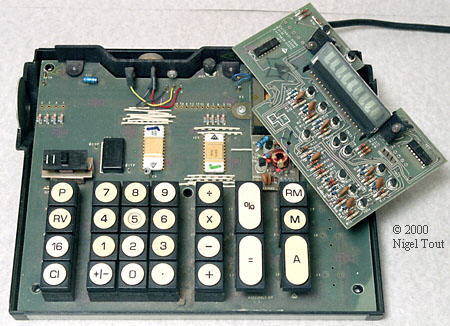
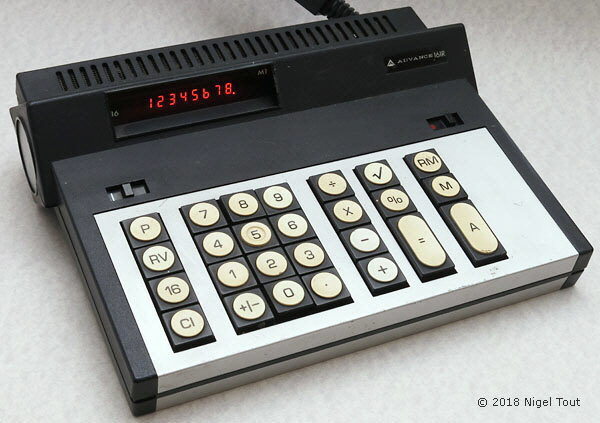
Advance 161R desk calculator with one memory and square root.
8 Digits, Panaplex II amber gas discharge display behind red filter.
Will accept and calculate with 16 digits and display either the 8 most-significant digits or 8 least-significant digits as needed.
4 function, %, square root, memory.
The two main integrated circuits have the Advance Electronics "A" logo printed on them, since they are custom designs for Advance. One is the GIM4 53143 from General Instrument Microelectronics, and the other (date-coded week 11 of 1974) has the part number H52973 and no other indication of manufacturer, but would be GIM.
252 mm x 200 mm x 72 mm (10" x 8" x 3").
Announced in September 1973 with a price of GBP £130[2] (about US$300).
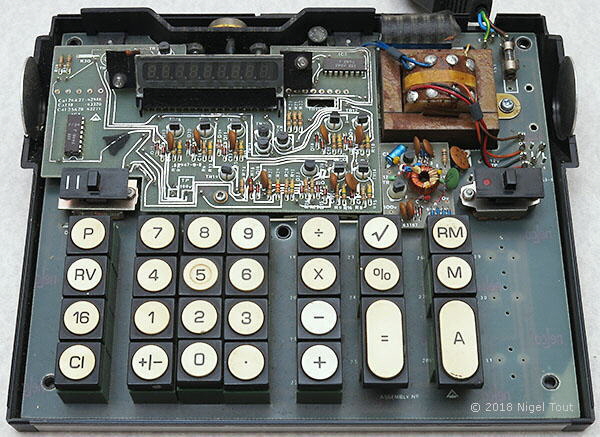
With the cover removed, showing the main circuit board with the display daughter board. The display is amber gas-discharge.
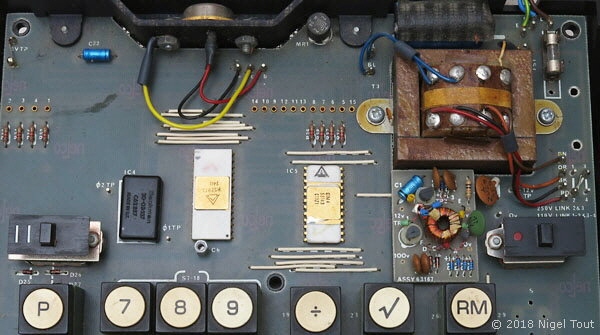
The display daughter board has been removed to reveal the main integrated circuits.
Both have the Advance Electronics 'A' logo, and the one on the right is a GIM4 from General Instrument
Microeletronics.
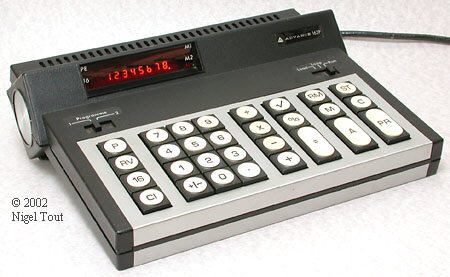
Advance 162P Programmable desk calculator.
8 Digits, amber gas discharge behind red filter.
Will accept and calculate with 16 digits and display either the 8 most-significant digits or 8 least-significant digits as needed.
4 function, %, memory, square root, programmable. The journal Electronics Today International reported "The programmability is restricted to a total of 40 steps over two programs one up to ten steps and one to 30 steps, these are enough for most engineering and scientific calculations. ... there is no 'compare' available and thus whenever a comparison was required the machine stopped for a manual comparison and then a continue or switch to program 2 instruction was given - manually".[5]
The four main integrated circuits are from General Instrument Microeletronics. They have the Advance Electronics "A" logo printed on them, since they are custom designs for Advance and comprise GIMT4 53143, GIM4 53359, 2 off H52973 (here date coded early 1974).
252 x 200 x 72 mm (10" x 8" x 3").
Chips are date coded 1974.
The price in 1974 was GBP £199 (excluding VAT) (about US$460).
It was also available "In easy build kit form only £98 [about US$230] plus VAT!!!" "A very special off to readers of Wireless World." "In fact, the first programmable calculator, as far as we know, ever sold in kit form."[6]
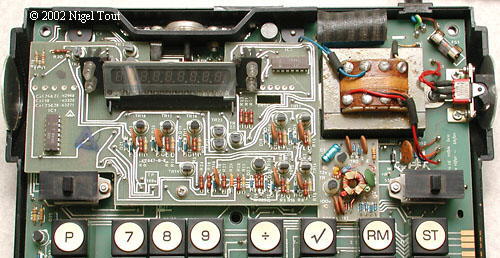
With the cover removed, showing the main circuit board with the display daughter board. The display is amber gas-discharge.
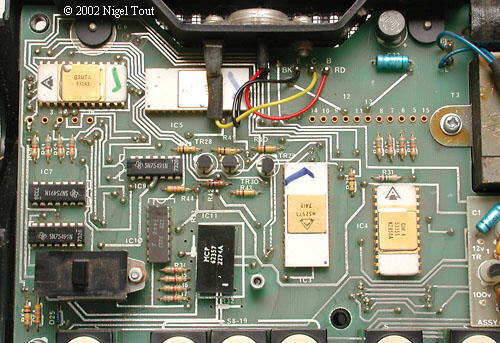
The display daughter board has been removed to reveal the integrated circuits.
The main ones are from General Instruments Microeletronics.
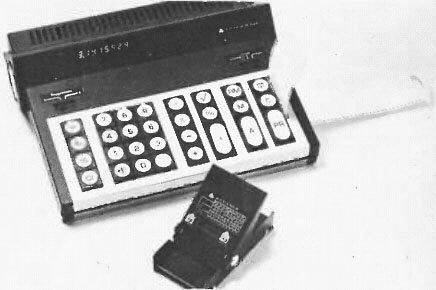
Advance 162P with the 'Plastic Tape Input' (on the right) and the mechanical punch.
In December 1974 the journal Electronics Today International described the 'Plastic Tape Input'[5]:
"... the memory
was mains dependent and so the machine had to be reprogrammed after being disconnected from the mains. This fault has now been overcome with a new adaptation to the basic 162P calculator which consists of a plastic strip with
instruction steps punched into it on a simple mechanical punch similar to an ordinary portable paper-tape punch.
In operation, the new programming device bypasses the calculator keyboard: the program is punched as a
series of indentations on a sprocketed plastic strip which is fed over a sensing device by a miniature drive motor. A novel principle is used in the patented sensing device; the indentations in the plastic strip are detected
by a row of miniature ball bearings which then depress a strip of electrically conductive rubber onto a row of contacts. The 162P calculator fitted with the new programming mechanism and complete with the punch costs
£249. In addition Advance Electronics is making available a series of commonly used programs and providing an advisory service to users who wish to write their own routines."
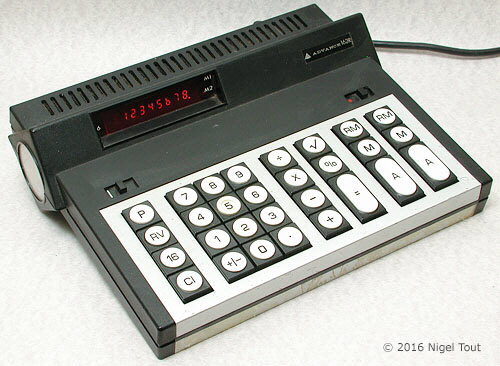
Advance 162R desk calculator with square root and two memories.
8 Digits, amber gas discharge behind red filter.
Will accept and calculate with 16 digits and display either the 8 most-significant digits or 8 least-significant digits as needed.
4 function, %, memory, square root, 2 memories.
The main integrated circuits are from General Instrument Microeletronics. They have the Advance Electronics "A" logo printed on them, since they are custom designs for Advance and comprise GIMT4 53143 and H52973 (here date coded early 1974).
252 x 200 x 72 mm (10" x 8" x 3").
Announced in September 1973 with a price of GBP £175[2] (about US$400).
Is similar to the Advance Executive 16R but has a Panaplex display instead of red LED, and has a '+/-' key.
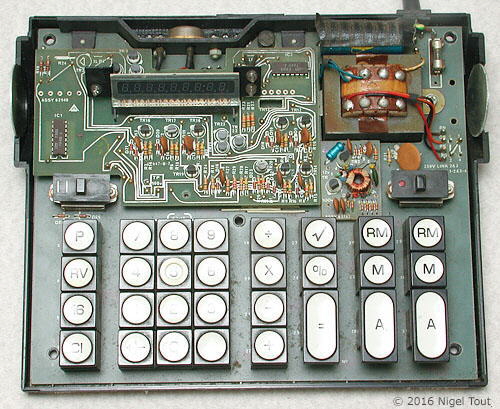
With the cover removed, showing the main circuit board with the display daughter board. The display is amber gas-discharge.
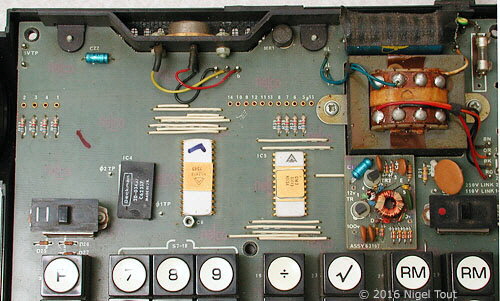
The display daughter board has been removed to reveal the integrated circuits.
The main ones are from General Instruments Microeletronics and have the Advance Electronics 'A' logo printed on them.
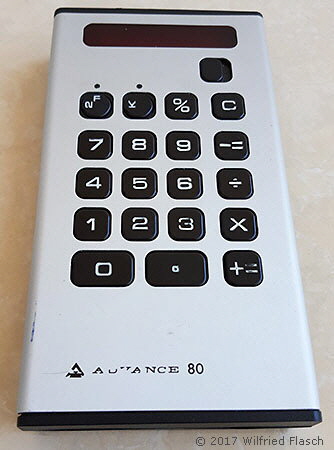
Advance 80
Display is 8 digits, red LED.
4-functions.
9v (6x AA batteries).
Main calculator integrated circuit: Texas Instruments TMS0128.
Similar to the Advance Mini Executive but with a different main integrated circuit.
The decimal-point setting key (marked '2' for currency calculations and 'F' for floating point calculations) and the constant key (marked K) are unusual in that they have to be pressed in and rotated to set them.
The example pictured was marketed by Yizrael - R.D.T. Ltd., Israel.
This model was introduced at the 1973 Business Efficiency Exhibition[2]:
"The Advance 80,
ideally suited to financial calculations, incorporates a percentage feature enabling mark-up and discount calculations to be performed without re-entry of data or the need for preliminary calculation. Answers are displayed to
eight significant digits with fully floating decimal point. The user may optionally fix the decimal point to display answers 'round-off' at two decimal places, and the instrument will chain calculate, square automatically,
and features the very important 8-digit constant facility in both multiply and divide.
The Advance 80 may be used on internal dry batteries or operated on an optional mains adaptor which doubles as a desk
plinth. This mains unit is also designed for re-charging optional rechargeable cells whilst the calculator is in use on the stand. The recommended price is £57.50."
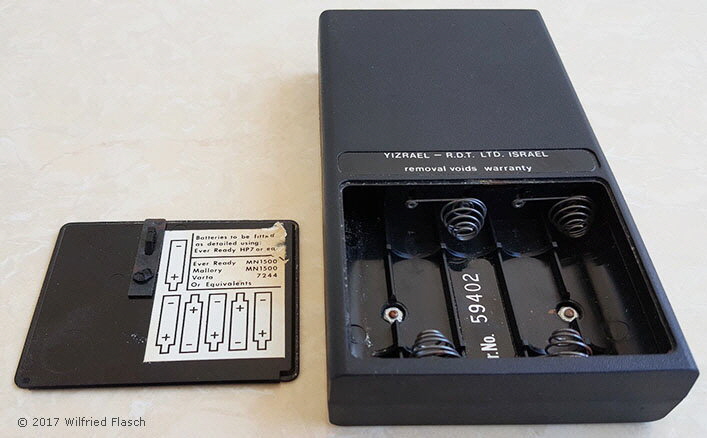
The battery compartment of the Advance 80, showing how the 6x AA cells were arranged. The requirement for such a large number of these cells is unusual.
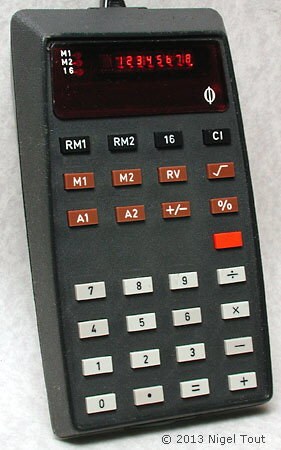
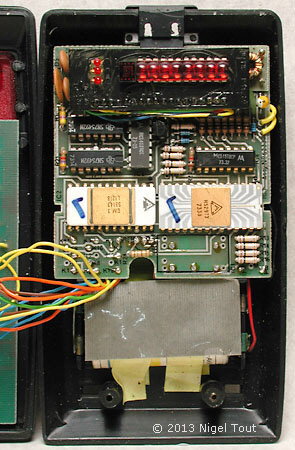
Advance 82R , aka Phytron 32
Display is 8 digits, red LED.
Four functions, %, 2 memories, square root. Can calculate to 16 digits.
5.5v (5x rechargeable AA batteries).
Main integrated circuits: General Instrument Microelectronics GIM3 53143 and one marked H52973 (here date coded to mid-1973). Both have the Advance Electronics "A" logo printed on them, since they are custom designs for Advance manufactured by GIM. This circuit board is similar to that used in the Advance 88.
Size: 87 x 181 x 45 mm (3.4" x 7.1" x 1.75").
The selling price in 1974 was GBP £136[8] (about US$320).
Phytron Electronics Ltd., of 117 Charterhouse Street, London EC1, was a British calculator marketing company. Together with Fi-Cord it took on the distribution in Britain of ANITA hand-held calculators, and also a couple of models under its own name which were made for it by Advance Electronics .
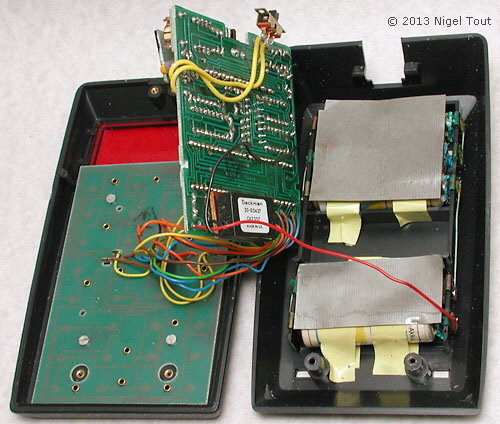
Underneath the circuit board are three more AA rechargeable cells, to give a total of five.
The publication "Electronic Calculator Markets and Suppliers", 1974, gives the price at £136 GBP[9] [about US$320], which is very high, but this example was bought at the Advance Electronics factory shop on 24th October 1975 for £10-80 [about US$25]. Although labelled as a Phytron 32 the invoice with the calculator describes it as an Advance 82R.
Graham Lewendon was for a time the only inspector on the hand-held calculator assembly line at the Advance Electronics Bishop's Stortford factory. Graham recalls:
"I clearly remember the
introduction of the Phytron 32 as it used a different keyboard made in house at the Bishop's Stortford factory. Also it was supplied with an internal set of rechargeable batteries, and the game we had getting the first products
made to fit together until we learnt the knack!"
There are more of Graham's recollections further down this page.
Note that this chunky model is unusual for a non-scientific hand-held calculator of this time in that it calculates to 16-digits, has 2 memories, and requires 2 main integrated circuits. The published price is very high (two ceramic packaged integrated circuits would be expensive) and it may have been sold off cheaply in 1975, by which time the cost of calculators had plummeted.
Click here for more information about Phytron calculators.
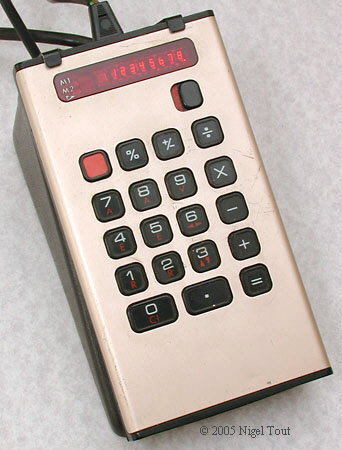
Advance 88 photographed mounted on the AC adapter unit.
The front of the casing is gold-coloured.
Advance 88
Display is 8 digits, red LED.
4-function, %, two memories, square root.
Main integrated circuits - General Instruments Microelectronics / Advance GIMT4 53143 and Advance H52973 (here date coded late 1973).
This model was introduced at the 1973 Business Efficiency Exhibition[2]:
"The Advance 88 has
been developed specifically to offer features that are normally associated with larger and more powerful desk calculators. It is claimed to be the most sophisticated general purpose handheld business calculator available from
a U.K. manufacturer. The calculator is a full 16-digit floating point unit with 2 accumulating memories and automatic square root key. Although strictly a handheld model the 88 has full size key switches and will
operate for several hours on built-in rechargeable batteries. When required the calculator can be used in conjunction with the special mains powered desk top recharger unit. Advance claim this unit to be a World first
at the recommended price of £115."
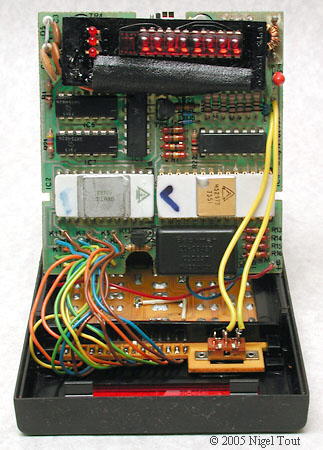
The cover has been removed to show the circuit board with the General Instruments/Advance GIMT4 53143 and Advance H52973 integrated circuits in ceramic packages. This circuit board is similar to that used in the Advance 82R Phytron 32.
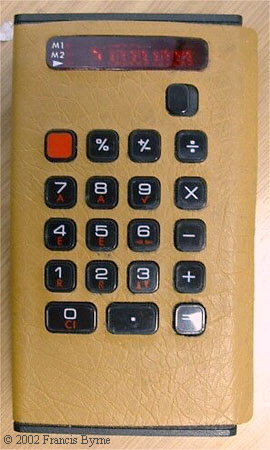
The version above has a very unusual leatherette cover to the keyboard. As Graham Lewendon explains below in his recollections of working at Advance, this was fitted due to problems in keeping the metal trim attached.
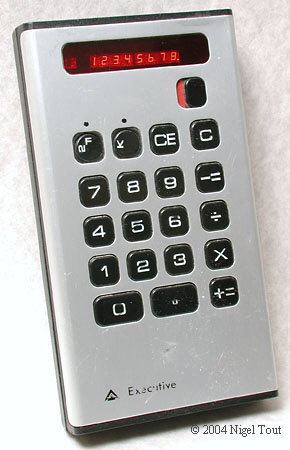
Advance Mini Executive
Display is 8 digits, red LED.
4-functions.
9v (6x AA batteries).
Main calculator integrated circuit: Texas Instruments TMS0103.
Introduced 1972.
Cost GBP £52.50 (about US$134).
Similar to the Advance 80 but with a different main integrated circuit.
The decimal-point setting key (marked '2' for currency calculations and 'F' for floating point calculations) and the constant key (marked K) are unusual in that they have to be pressed in and rotated to set them.
This model was available as a self-assembly kit, see below.
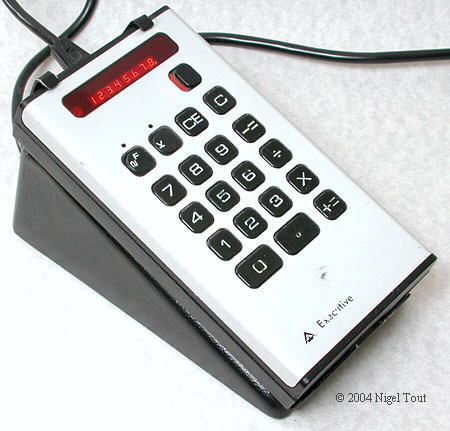
Mini Executive mounted on the AC adapter unit.
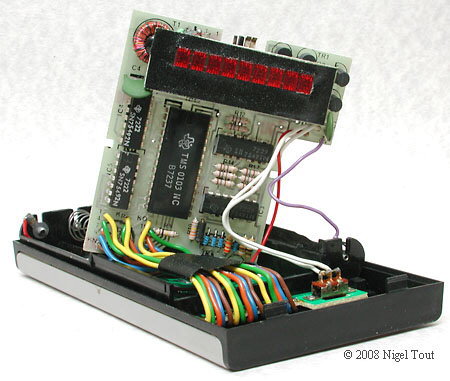
The circuit board of the Advance Executive, showing the LED display at the top and the large Texas Instruments TMS0103 calculator integrated circuit, here date coded week 37 of 1972.
The Advance Mini Executive, above, was developed as a self-assembly kit. In October 1973 the journal Electronics Today International explained[7]:
"The Advance International Portable Calculator
... the Advance Executive is one of the best sellers in this
country and also this company have quite a bit of experience in calculator kits. They produced some time back the first calculator kit known to us (featured in Wireless World) and for some time
have been exporting the Executive in virtually kit form for assembly overseas.
...
The International
Advance will be launching this kit known as the
International on October 19th ...
...
Calculator Features
The Advance International is identical to the Executive except that you build it up
yourself ..."
In January 1974 an advertisement appeared in Electronics Today International (E.T.I.)[8]:
"Now you can build your own hand-held calculator for £29.95 [about US$70].
(In less than three hours.)
This calculator started life as the Advance Mini Executive. For £57.75.
Then, in conjunction with E.T.I., we developed it, improved it—and now offer it to you
for only £29.95."
- Company details
The following history is derived from information provided by Pat Meads, a former employee who was a production supervisor and was involved in the assembly of their first calculators, and from an archive of the website of Advance Electronics Ltd. at https://web.archive.org/web/20150710122538/http://www.aelgroup.co.uk:80/products/history.php:
The company was started by A.W. Stapleton in his garden shed. Advance Components Ltd. was formed on 24th March 1932, initially producing radio components, RF chokes, and small sub-assemblies, and soon entered the field of electronic test equipment.
In 1956 it moved from Walthamstow to larger premises in Hainault, Essex, and the company went public. The name was changed to Advance Electronics in 1964, and about 1968 it moved to a new factory in Bishops Stortford, and a
factory was also opened in Wrexham.
The five main business sectors were then:
- Metalised Film Capacitors, for the electronics, communication and automotive industries and in the group's own products. Manufactured in a plant at Wrexham.
- Industrial Electronics, control equipment, power supplies, constant-voltage transformers.
- Electronic Test Equipment, for industrial and research applications.
- Special projects, involving electronic systems.
- Printed circuit boards, for use by the group and under subcontract.
In 1971 the group had about 1100 employees, with distribution through 33 countries, and sales figures of around £3.4 million (about US$8 million).
Since then the company was bought by Gould, had a management buyout from Gould, merged with other companies, and demerged again.
It is still in existence, based in Wrexham, and specialises in Uninterruptible Power Supplies
(UPS), Power Conditioners, and related products.
High Reliability
Advance designed their machines with reliability in mind, as reported in the journal Electronics in May 1972[9]:
"Service. To Briggs [calculator production manager], the key is a machine that has a very low risk of going
wrong and rarely needs servicing. "I know that some of our rivals dissipate most of their sales profits in servicing costs." he says. "Others save money by providing poor service for unreliable machines,
and those companies won't last. We believe that we genuinely won't need to spend much money on servicing. Once we've got a reputation for reliability, [a lot of business] should come our way," he
said.
"Advance's approach to reliability has been to use high quality components, where necessary built to Briggs' own specifications, and in some cases with integrated functions, to push down the number of components
used. The keys are sealed reed relays built initially by Alma Components Ltd. to an Advance spec. The clock circuitry contains a temperature-compensated multivibrator integrated with other functions as a thick-film
hybrid, and the power input is solid-state regulated. The eight-digit-plus-sign readout is a single light-emitting-diode module, which for the larger machines is made complete with drivers by Fairchild and for the smallest
machine is made with separate drivers by Texas Instruments.
Assembly line. The biggest machine in the range—with 16 digits (the last eight displayed), two
data registers, a constant register, and two direct transfer accumulators, and with a half-dozen special functions aimed at engineers and statisticians—uses 45 component types including nuts and washers, or about 70
components in all.
Consequently Advance's part in making the machines boils down mostly to design, assembly, and quality control. The test process includes a 48-hour bake at 50°C and a period on a
vibration rig. Briggs reckons that, neglecting overhead, 95% of production costs are for materials and only 5% labor.
The basis of Advance's range is a group of four 16-digit, floating point desk calculators
in a molded case, using metal-nitride-oxide-semiconductor chips built by General Instrument Microelectronics Ltd. to Advance's logic design. These machines, which will be available in the fall, all have automatic
clear.
Range. The simplest machine is built around two chips and is a straightforward office calculator with a percent key. A similar machine features
metric conversion functions and a direct transfer accumulator store. Another comes with value-added-tax functions and two stores. Then, there's the top machine, built around five chips, aimed at engineers and
statisticians. It will cost less than $500. A fifth model, priced at $350, is a simple calculator plus a 55-by-12-bit shift register memory programed to remember and add a matrix of figures vertically while the user is
entering and adding them horizontally, as is done in ledger accounting.
At the bottom of the range, priced at about $200, is an eight-digit, four-rule machine which comes with the same case and peripheral components
as the others but is built around the Texas Instruments standard MOS calculator chip. The chip is followed by four Darlington amplifiers to drive the TI LED readout. A multiplying or dividing constant can be used.
Briggs has in development a pocket version of this machine using a smaller readout, dry batteries, and special keys."
Custom integrated circuits for Advance calculators
The semiconductor company General Instrument Microelectronics had a factory in Britain, in Scotland, and offered
some custom design and manufacture. Advance took advantage of this and the GIM integrated circuits used in most of their calculators are stamped with the Advance "A" logo. The integrated circuits developed appear to
have some programmability, with similar parts used in models with different functionality.
The use of custom MOS integrated circuits to simplify the design of different models and reduce costs was explained in the following article in The Engineer[10]
"
Custom chips slim down the design of calculating machines
Company making calculating machines has developed special
slot-in logic chips to simplify design and cut costs. By David Millichamp
The extraordinary development of electronics over the last decade or so has opened new fields not just for the electronics engineer but also to any engineer with a logic problem to solve.
Curiously
enough, it is the very complexity of electronics, with its baffling array of letters like MOS and TTL combined with its almost mystically compact packaging, that has brought electronics so much further into the mechanical
engineer's domain.
Any engineer worth his salt has to know at least something about computers and, hence, by implication, must also know something about logic. In today's world, anyone who can work out a
system of logical operations to carry out a particular job can design that system in terms of electronics. It has become possible to draw out a diagram of all the operations needed, send it to one of the integrated circuit
companies and, lo and behold, the complex logic diagram returns as a tiny chip ready to slot straight into a printed circuit board.
Distrust. The control
engineer, of course, is in an even better position to use such methods, unless his eyes are fettered by a historical distrust of something he cannot see and feel.
The only flaw in this cosy picture of convenient
production is the price; it could cost between £5,000 and £10,000, though the cost for an individual MOS integrated-circuit chip could work out at as little as £1 or even less, depending on the complexity of the
job.
To put this into perspective it is important to recall that a few years ago a single thermionic valve with associated resistors and capacitors carrying out a single function could cost something like £1 —
whatever the quantity involved.
For £1 today it is possible to obtain several thousand functions. The change in scale, costs, reliability and potential staggers the mind. So, too, does the pace of the
revolution that has brought this about. Electronics has moved from thermionic valves to transistors, to TTL logic, to MOS all in the space of 20 years.
For the moment it is tempting to cry 'Halt. Let
us digest what we have now. How many have progressed as far even as transistor circuits'.
But this is the whole point: there is no need to know how to design electronics circuits. The essential point
is to know what can be done with electronics and then appoint someone else to do the donkey work.
Calculating. In practice, it is possible to do much of the
design work so that not all stages in the integrated circuit design and production procedure have to be carried out by the custom-building company.
A typical user of MOS — metaloxide-silicon integrated
circuits is Advance Electronics; its electronics expertise helps them move along part of this road. The integrated circuits chips used in its new range of Executive 16 calculators are the result of working out just what logic
is required and putting this in an easily translateable form that the custom-builders can turn into hardware.
Electronic calculators present special problems to designers because they are a new phenomenon and
because Japan flooded the market with relatively cheap machines.
One way round this is to produce a better machine at the same price level. MOS integrated circuits allow this to be done because they reduce the
number of separate or discrete components to a minimum, thus reducing assembly costs drastically.
This picture is complicated by the availability of standard chips specifically designed for calculators. With
these at hand almost any self-respecting engineer can put a calculator together.
Display. All he needs is a display, driving transistors for this display, some
logic chips, a keyboard and a case. Variations on these produce a pocket calculator, a desk calculator, a calculator for VAT, for trigonometric functions or what you will.
But it is a path strewn with hazards
— economic and otherwise. Advance's various electronic calculators were due to appear in October 1971. But this particular point occurred half-way through a price war of attrition in electronic calculators.
Advance's original solution had been to develop its calculators round a series of computer chips that could be programmed to perform the functions required of a particular machine.
The idea was that extras cost
little so why not develop a range of chips that could be modified to do many different jobs. Unfortunately, this non-specialised approach proved too expensive for calculators, though still satisfactory for
minicomputers.
So Advance reduced the number of chips necessary in each calculator by adopting the Texas Instrument's standard 1802 chip for the smaller machines, but developing its own for the larger
machines.
These special chips are programmable in the sense that minor modifications at the production stage can alter the memory of the chip to make it carry out different functions. This change costs about
£200 — a relatively small amount to add to a basic cost measured in thousands.
For the calculators logic chips were reduced from eight to three, simplifying construction and reducing costs.
Specify. One significant factor of MOS integrated circuits is that the designer can virtually specify the characteristics of the individual components. He can, for instance, give
the `transistors' on the chip whatever characteristics he likes within the limits the technology. Gain, on-resistance, frequency response all come within the scope of the designer.
As Peter Rush, General
Instrument's MOS standards product manager suggests, it is not possible to use earlier designs very extensively because they go out of date so fast. 'All the time people are asking for faster cycle times —today
it's up to 5-10 MHz' says Rush.
General Instrument is typical of MOS producing companies. Inevitably American, it produces custom and standard MOS chips at its Glenrothes plant in Scotland which was
set up in '968 in anticipation of the current boom in MOS.
GI produces Advance's custom chip at Glenrothes from Advance's logic circuit. 'It is important', says Advance's technical director John Mitchell,
'to have your MOS supplier's design team in Britain.'
With the initial design settled, the chip is simulated at Glenrothes using a terminal linked to a computer in Edinburgh. Required signal inputs are
generated and outputs are checked to make sure they correspond. Modifications are made until the whole theoretical circuit functions correctly.
Even these modifications can be carried out by computer and this
reduces production time. 'But the computer,' says Rush, 'cannot produce 100% the best circuit — there seems to be a human element required.'
The MOS chips start life on a 50 mm diameter slice of pure silicon
about 0.13 mm (0.005 in) thick. The chips are usually 5 mm square, so a single slice produces about 300 chips.
Expensive. Depending on quantity, production
of the chip does not generally represent the most expensive part of the process. This comes later, when actual electrical connexions have to be made and each chip has to be fitted into an appropriate package.
Each chip carries up to 40 pads 0.1 mm square to which go wires have to be soldered by hand under a microscope. In large production runs the cost of this dominates the overall cost, and for this reason many standard MOS chips
are produced in the Far East.
Part of the problem with MOS lies, to some extent, with its inflexibility. It is possible, like Advance, to make relatively low-cost modifications to the masks and change some of
the operations the chip will do but the initial costs are still high and MOS in this form is restricted to digital systems. For smaller runs it could well be better to turn to the older TTL — transistor-transistor-logic
— systems, which, though incapable of high packing densities of MOS, offer much greater flexibility.
They also allow easier input of analog data, which suits the control engineer.
On the other
hand for large-scale production of systems that formerly used levers, pneumatics or some other form of logic, or even for systems that could not be considered before because of their complexity, MOS has much to offer."
Advance Electronics the third largest UK producer of electronic instruments
The report "Electronic Calculator Markets and Suppliers", of 1974[11], says that Advance is "the third largest UK producer of electronic instruments. Electronic calculators account for nearly 20% of its sales, or £1M last year. It is
technically perhaps more soundly based than Sinclair, but proportionally less interested in the mass market, with production of 20,000 units per annum."
Calculator Manufacture at Advance Electronics
Graham Lewendon was for a time the only inspector on the hand-held
calculator assembly line at the Bishop's Stortford factory of Advance Electronics, in Raynham road, from late 1973 until early 1975. He has kindly sent his very interesting recollections of his time with the calculators
there:
"Examine the battery compartment on any of the silver calculators (known as cal 5 & cal 12 in factory). One version was a very simple model. The other had the % function. The gold trimmed units
came with % and sq root function plus the twin memory. The inspection stamp ink is often yellow and of a solvent based ink and takes form of a number inside a triangle. If only I could remember my old inspection
number. We used to place it between the ribs that separated each battery.
Re. your comments about the display of the advance 88. Yes it did display 8 digits, but it was a switched bank of 16, i.e. if the answer was 1.234567898765432 then pressing a manual selector switch displayed either one part of the answer or the other. We had a simple function test of 100 divided by 81 = 1.2345679. A more elaborate test being performed by test and trouble shoot engineers.
The silver and gold satin metal trims were so hard to keep attached to the plastic front case that simply placing thumb nail edge between lower curved corner where metal butted against plastic shoulder then twisting thumb nail (if it withstood this it passed inspection) could prise metal trim away from case. We tried many ways to prevent this lifting in the early days using a product we knew as IS12 or a thicker variant IS150, both being industrial super glue. After some time an improvement was made using thin double sided adhesive tape away from key pad area. This is reason for the fabric covered fronts [see the yellow Advance 88 above].
The red LED display had the black colour applied to the surround using nothing more than a black marker pen with the black tape over row or pin ends because the maker pen could not hide the metal end so it was used to make display look better than it really was. The 3 button LEDs on the left had the function of telling what part of the display was being shown plus which memory bank was accessed.
I clearly remember the introduction of the Phytron 32 as it used a different keyboard made in house at the Bishop's Stortford factory. Also it was supplied with an internal set of rechargeable batteries, and the game we had getting the first products made to fit together until we learnt the knack!
I also recall the day we had some oriental gentlemen visit the production line and afterwards some of us felt that it was only a matter of time till our jobs disappeared. I seem to recall talk of whether we could encapsulate inner workings with epoxy resin to make reverse-engineering that bit more difficult. If only I knew then what I was only to learn 20 years later when making components for videojet ink jet print heads with 256 jets per head about epoxy resin and heat from a hot air gun! But we tried our best at the time.
There was always a problem with petty theft such that hand-held's product line had to move into what was known as the "glass house" thus preventing non-line employees reaching over high inward facing angled board and stealing parts to make their own calc.
We all went into work one day and with no prior warning the whole team was reassigned to build power supplies for Rank photocopiers but that's another bit of history. Looking at your site images turns the clock back a long time. Sorry that's all I remember after 25 years but I hope some of what I have shared with you is new to you.
Advance Electronics 'Ruby' calculators - Several calculators are known under the name 'Ruby' and labelled 'Advance Electronics Co. Ltd.' on the back. These machines were manufactured in Taiwan and do not appear to be related to Advance Electronics Ltd. of Bishops Stortford. See examples in the Photograph Gallery of the Vintage Calculators site. If you have any information about those calculators please get in touch.
References:
- "News Briefs", Practical Electronics, November 1972, p948.
- "Six New Calculators introduced by Advance", Electronics & Power, September 20, 1973, p410.
- "Industry Notebook", Practical Electronics, December 1974, p1089.
- "Calculators - the kit approach", The Engineer, 19th October 1972, p18.
- Miller-Kirkpatrick, John, "Electronics Tomorrow: Programmable calculator with plastic tape input", Electronics Today International, December 1974, p64.
- Wireless World, October 1974, page a65.
- "The Advance International Portable Calculator", Electronics Today International, October 1973, p44.
- Electronics Today International, January 1974, p2.
- "Advance moves into calculators", Electronics, May 22 1972, p5E.
- Millichamp, David, "Custom chips slim down the design of calculating machines", The Engineer, 20 September 1972, p62-63.
- Milton, R., Beaumont, A.J. (1974), Electronic Calculator Markets and Suppliers, 2nd. ed., Finresearch Series, London: Ovum.
Vintage British Calculators
Text & photographs copyright, except where stated otherwise, © Nigel Tout 2000-2025.